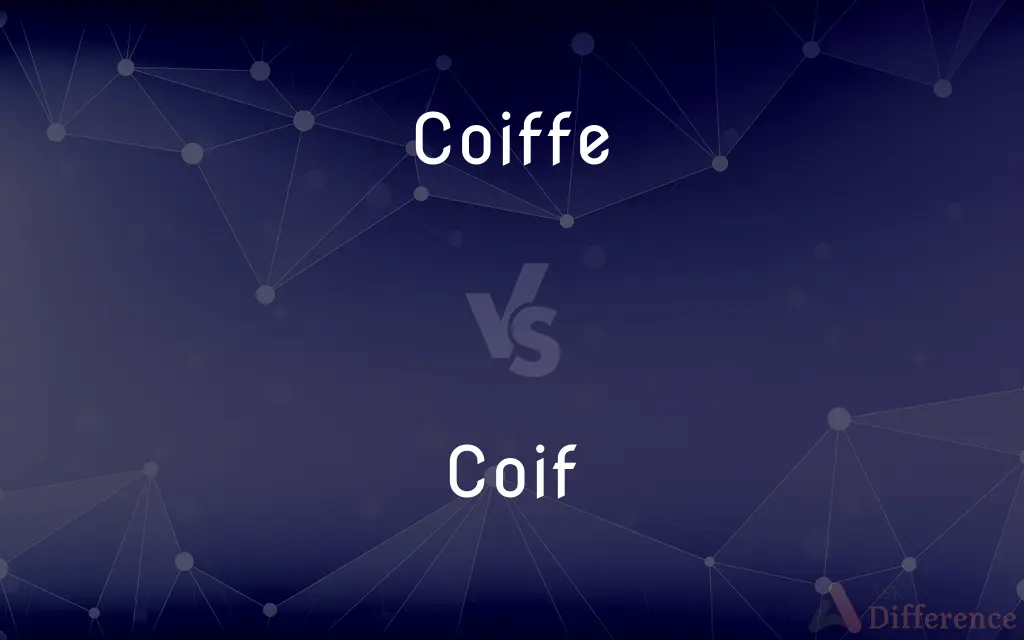Coiffe vs. Coif — What's the Difference?
By Tayyaba Rehman & Urooj Arif — Updated on April 1, 2024
Coiffe refers to the act of styling hair or a head-covering, while coif denotes a close-fitting cap, historically worn under helmets or as part of a legal, clerical, or academic dress.

Difference Between Coiffe and Coif
Table of Contents
ADVERTISEMENT
Key Differences
Coiffe, rooted in the verb "to coif," involves the act of arranging or dressing the hair, often implying a more elaborate or careful styling. It can also refer to a hairstyle or headgear that has been styled in a particular manner. Whereas, coif specifically refers to a type of headgear, which can range from a simple, close-fitting cap worn for modesty or protection, to a part of historical, legal, or academic attire. The term coif historically denoted a white linen cap worn by English lawyers or a metal skullcap worn by knights under their helmets.
The distinction between the two terms lies in their usage and context. Coiffe is more commonly used in French or in the context of fashion and hairstyling. It emphasizes the action or result of styling hair or wearing head-coverings for aesthetic purposes. On the other hand, coif has a narrower scope, focusing on the specific item of headwear itself, with historical and professional connotations.
In modern usage, coif can still be found in discussions about historical attire, legal dress in some jurisdictions, or as a general term for hairstyles, particularly those that are neat and closely fitted to the scalp. Coiffe, though less common in English, might appear in fashion or historical literature, emphasizing the art or manner of hairdressing or the wearing of elaborate headpieces.
While coiffe conveys a broader sense of style and presentation regarding hair and headgear, coif highlights the historical and functional aspects of specific types of headwear. The evolution of these terms reflects changes in fashion, social norms, and professional attire, indicating their roots in historical dress and the continuing influence of language and culture on fashion terminology.
Understanding the nuances between coiffe and coif sheds light on the rich tapestry of language and fashion, offering insights into how terms evolve and intersect with culture, history, and profession.
ADVERTISEMENT
Comparison Chart
Definition
Act of styling hair or a styled head-covering.
A specific type of close-fitting cap or headwear.
Usage
Broader, involving styling or fashion.
Narrower, referring to specific headgear.
Context
Fashion, beauty, and hairstyling.
Historical attire, legal, clerical, academic dress.
Connotation
Aesthetic, style-oriented.
Functional, historical.
Examples
Elaborate hairstyles, fashion headpieces.
Linen caps for lawyers, skullcaps for knights.
Compare with Definitions
Coiffe
Can refer to elaborate head-coverings.
Her coiffe for the gala was a masterpiece of woven silk.
Coif
A close-fitting cap, historically worn under helmets.
The knight's coif provided a layer of protection.
Coiffe
The act or style of arranging hair.
The bride's coiffe was adorned with flowers and pearls.
Coif
Used in legal, clerical, or academic dress.
The barrister's coif was a symbol of his profession.
Coiffe
Pertains to fashion and aesthetic hair arrangements.
The fashion show featured models with avant-garde coiffes.
Coif
Refers to neat, tidy hairstyles.
She wore her hair in a simple, elegant coif.
Coiffe
Involves creative hairstyling techniques.
The stylist specialized in historical coiffes for film.
Coif
Historical headgear with specific functions.
In medieval times, a coif was essential for knights' safety.
Coiffe
Sometimes used to describe the overall look of hair and headgear.
His coiffe was reminiscent of 18th-century nobility.
Coif
Can denote a protective or modest head covering.
The nuns wore linen coifs as part of their habit.
Coiffe
Alternative spelling of coif
Coif
A coif is a close fitting cap worn by both men and women that covers the top, back, and sides of the head.
Coiffe
Arrange attractively;
Dress my hair for the wedding
Coif
(also kwäf) A coiffure.
Coif
A tight-fitting cap that covers the top, back, and sides of the head and is now often worn under a veil, as by nuns.
Coif
A white skullcap formerly worn by English lawyers.
Coif
A hood of chain mail or other heavy material, usually worn under a helmet.
Coif
A cervellière.
Coif
(also kwäf) To arrange or dress (the hair).
Coif
To cover with or as if with a coif.
Coif
A hairdo.
Coif
(historical) A hood; a close-fitting cap covering much of the head, widespread until the 18th century; after that worn only by small children and country women.
Coif
(historical) A similar item of chain mail headgear covering the head.
Coif
An official headdress, such as that worn by certain judges in England.
Coif
(transitive) To style or arrange hair.
Coif
A cap.
From point and saucy ermine downTo the plain coif and russet gown.
The judges, . . . althout they are not of the first magnitude, nor need be of the degree of the coif, yet are they considerable.
Coif
A coiffure.
Coif
To cover or dress with, or as with, a coif.
And coif me, where I'm bald, with flowers.
Coif
A skullcap worn by nuns under a veil or by soldiers under a hood of mail or formerly by British sergeants-at-law
Coif
Cover with a coif
Coif
Arrange attractively;
Dress my hair for the wedding
Common Curiosities
Can coif be used to describe hairstyles?
Yes, particularly those that are neat and closely fitted, though it primarily denotes headgear.
What is the primary difference between coiffe and coif?
Coiffe relates to the styling of hair or a head-covering, whereas coif refers to a specific type of headwear.
Is coiffe used in modern English?
It's less common and may appear in contexts related to fashion, hairstyling, or historical literature.
What historical significance does coif have?
It has roots in medieval and early modern Europe, used for protection, modesty, or as part of professional attire.
How do cultural differences impact the use of coiffe and coif?
Cultural and historical contexts greatly influence the meaning and use of both terms, reflecting variations in fashion and professional attire.
Does coiffe imply a certain level of formality?
Not necessarily; it can range from everyday styling to elaborate arrangements for special occasions.
Can someone wear a coif today?
Yes, in certain professions or ceremonial contexts, such as in courtrooms or historical reenactments.
Are there gender-specific connotations with coif or coiffe?
Historically, yes, but in modern usage, they can apply to any gender, depending on the context and style.
What's the importance of understanding terms like coiffe and coif?
It enriches our appreciation of language's role in fashion, history, and cultural identity, highlighting the evolution of style and professional norms.
How does coiffe relate to fashion?
It implies an aesthetic or stylish aspect of hairdressing or wearing headpieces, often with a sense of creativity or elaboration.
Share Your Discovery

Previous Comparison
Cabinet vs. Pantry
Next Comparison
Bay vs. HarborAuthor Spotlight
Written by
Tayyaba RehmanTayyaba Rehman is a distinguished writer, currently serving as a primary contributor to askdifference.com. As a researcher in semantics and etymology, Tayyaba's passion for the complexity of languages and their distinctions has found a perfect home on the platform. Tayyaba delves into the intricacies of language, distinguishing between commonly confused words and phrases, thereby providing clarity for readers worldwide.
Co-written by
Urooj ArifUrooj is a skilled content writer at Ask Difference, known for her exceptional ability to simplify complex topics into engaging and informative content. With a passion for research and a flair for clear, concise writing, she consistently delivers articles that resonate with our diverse audience.














































